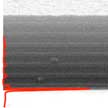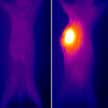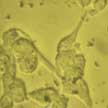Showing Spotlights 817 - 824 of 2879 in category All (newest first):
 Countless commercial and industrial products are routinely produced by manufacturing processes where solid parts are molded through injecting molten polymer into a cast and removing the finished shape once cooled. This process is well understood for solid materials. If the characteristics and properties of a liquid are of interest, e.g., ion transport or mobility, the ability to structure liquids into complex shapes becomes highly desirable. It would open a wide range of potential applications in areas such as all-liquid reaction vessels, energy storage materials, all-liquid electronic devices, and microfluidic devices. Researchers now have developed a very simple route to structure liquids by all-liquid molding.
Countless commercial and industrial products are routinely produced by manufacturing processes where solid parts are molded through injecting molten polymer into a cast and removing the finished shape once cooled. This process is well understood for solid materials. If the characteristics and properties of a liquid are of interest, e.g., ion transport or mobility, the ability to structure liquids into complex shapes becomes highly desirable. It would open a wide range of potential applications in areas such as all-liquid reaction vessels, energy storage materials, all-liquid electronic devices, and microfluidic devices. Researchers now have developed a very simple route to structure liquids by all-liquid molding.
Jan 22nd, 2018
 Inspired by the designs printed on T-shirts, researchers recently reported a new class of wearable power sources. To explore the feasibility of power sources directly printed on cotton T-shirts, which look like letters or symbols, they chose electric double layer supercapacitors based on activated carbon materials as a model electrochemical system. These T-shirts look and behave like a normal T-shirt but feature printed supercapacitors in the shape of letters and symbols.
Inspired by the designs printed on T-shirts, researchers recently reported a new class of wearable power sources. To explore the feasibility of power sources directly printed on cotton T-shirts, which look like letters or symbols, they chose electric double layer supercapacitors based on activated carbon materials as a model electrochemical system. These T-shirts look and behave like a normal T-shirt but feature printed supercapacitors in the shape of letters and symbols.
Jan 19th, 2018
 Plasmonic metasurfaces can be designed to achieve the singular-phase condition, yet this typically requires complex electromagnetic design and low-throughput fabrication techniques such as electron beam lithography. In a new work, researchers have developed a simple and robust planar singular-phase sensing platform for remote temperature detection, which does not require nano-patterning and exhibits singular-phase behavior due to the excitation of topologically-protected Tamm surface states.
Plasmonic metasurfaces can be designed to achieve the singular-phase condition, yet this typically requires complex electromagnetic design and low-throughput fabrication techniques such as electron beam lithography. In a new work, researchers have developed a simple and robust planar singular-phase sensing platform for remote temperature detection, which does not require nano-patterning and exhibits singular-phase behavior due to the excitation of topologically-protected Tamm surface states.
Jan 18th, 2018
 Researchers have merged two important technologies of nanomanipulation - plasmonic tweezers and magnetically driven microbots - in order to overcome their individual limitations and achieve new functionalities that did not exist before. This technique is applicable to different types of particles in various fluids. The resulting mobile nanotweezers' performance combines the best of both worlds: capturing, maneuvering, and positioning sub micrometer objects of various materials at low illumination intensities, high speeds, and with great control.
Researchers have merged two important technologies of nanomanipulation - plasmonic tweezers and magnetically driven microbots - in order to overcome their individual limitations and achieve new functionalities that did not exist before. This technique is applicable to different types of particles in various fluids. The resulting mobile nanotweezers' performance combines the best of both worlds: capturing, maneuvering, and positioning sub micrometer objects of various materials at low illumination intensities, high speeds, and with great control.
Jan 17th, 2018
 Nanofluidics is the study and application of fluids in and around geometries with nanoscale characteristic dimensions. The field of nanofluidics is not brand-new. Some issues associated with nanoscale fluidics have been occasionally dealt with by researchers in membrane science, colloid science, and chemical engineering for many decades. A recent review article provides a selected overview of the recent progress, rather than a comprehensive review of the entire field.
Nanofluidics is the study and application of fluids in and around geometries with nanoscale characteristic dimensions. The field of nanofluidics is not brand-new. Some issues associated with nanoscale fluidics have been occasionally dealt with by researchers in membrane science, colloid science, and chemical engineering for many decades. A recent review article provides a selected overview of the recent progress, rather than a comprehensive review of the entire field.
Jan 16th, 2018
 Optics and mesoscopic physics teams have discovered a new cooling mechanism concerning electronic components made of graphene deposited on boron nitride. The efficiency of this mechanism allowed them to reach electric intensities at the intrinsic limit of the laws of conduction. This new mechanism, which exploits the two-dimensional nature of the materials opens a 'thermal bridge' between the graphene sheet and the substrate. Researchers have demonstrated the effectiveness of this mechanism by imposing in graphene levels of electrical current still unexplored, up to the intrinsic limit of the material and without any degradation of the device.
Optics and mesoscopic physics teams have discovered a new cooling mechanism concerning electronic components made of graphene deposited on boron nitride. The efficiency of this mechanism allowed them to reach electric intensities at the intrinsic limit of the laws of conduction. This new mechanism, which exploits the two-dimensional nature of the materials opens a 'thermal bridge' between the graphene sheet and the substrate. Researchers have demonstrated the effectiveness of this mechanism by imposing in graphene levels of electrical current still unexplored, up to the intrinsic limit of the material and without any degradation of the device.
Jan 9th, 2018
 Researchers propose novel flexible Mn-doped zirconium metal-organic frameworks nanocubes for highly effective combination of microwave dynamic and thermal therapy against cancer. This is the first report of determining the microwave thermal conversion efficiency, which can be used to evaluate, compare, and predict the microwave sensitivity of different microwave-sensitive agents. More importantly, such Mn-ZrMOF nanocubes generate abundant reactive oxygen species of hydroxyl radicals under microwave irradiation.
Researchers propose novel flexible Mn-doped zirconium metal-organic frameworks nanocubes for highly effective combination of microwave dynamic and thermal therapy against cancer. This is the first report of determining the microwave thermal conversion efficiency, which can be used to evaluate, compare, and predict the microwave sensitivity of different microwave-sensitive agents. More importantly, such Mn-ZrMOF nanocubes generate abundant reactive oxygen species of hydroxyl radicals under microwave irradiation.
Jan 8th, 2018
 The role of artificial nanomotors integrated with therapeutic capabilities is a very promising field for clinical applications of medical nanotechnology. Researchers now have demonstrated the intelligent design of nanomotors with a single coating of ferrite, which act as a spacer layer as well as providing therapeutic potential by magnetic hyperthermia. These motors can be remotely maneuvered. The team also tackled the problem of magnetic agglomeration associated with ferromagnetic nanomotors, which limits their biomedical application.
The role of artificial nanomotors integrated with therapeutic capabilities is a very promising field for clinical applications of medical nanotechnology. Researchers now have demonstrated the intelligent design of nanomotors with a single coating of ferrite, which act as a spacer layer as well as providing therapeutic potential by magnetic hyperthermia. These motors can be remotely maneuvered. The team also tackled the problem of magnetic agglomeration associated with ferromagnetic nanomotors, which limits their biomedical application.
Jan 5th, 2018
 Countless commercial and industrial products are routinely produced by manufacturing processes where solid parts are molded through injecting molten polymer into a cast and removing the finished shape once cooled. This process is well understood for solid materials. If the characteristics and properties of a liquid are of interest, e.g., ion transport or mobility, the ability to structure liquids into complex shapes becomes highly desirable. It would open a wide range of potential applications in areas such as all-liquid reaction vessels, energy storage materials, all-liquid electronic devices, and microfluidic devices. Researchers now have developed a very simple route to structure liquids by all-liquid molding.
Countless commercial and industrial products are routinely produced by manufacturing processes where solid parts are molded through injecting molten polymer into a cast and removing the finished shape once cooled. This process is well understood for solid materials. If the characteristics and properties of a liquid are of interest, e.g., ion transport or mobility, the ability to structure liquids into complex shapes becomes highly desirable. It would open a wide range of potential applications in areas such as all-liquid reaction vessels, energy storage materials, all-liquid electronic devices, and microfluidic devices. Researchers now have developed a very simple route to structure liquids by all-liquid molding.
 Subscribe to our Nanotechnology Spotlight feed
Subscribe to our Nanotechnology Spotlight feed





